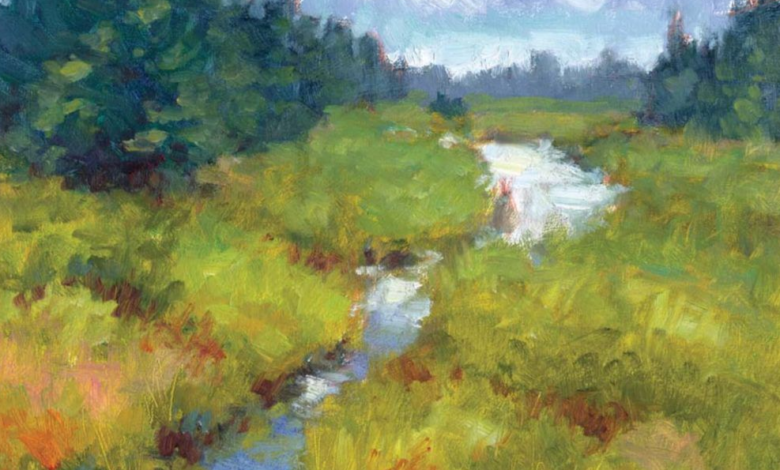Spice up your landscape by going green



Spice up your landscape by going green. I once spent a few weeks in the central highlands of Scotland teaching a painting retreat. It was my prime time there, and before I moved, my artist friends advised me to get ready for the amazing greens. Rather than adding a range of green tubing to my oil palette, I’ve opted for the same six colors that have served me well over the years on the Maine coast and the desert southwest.
Although I have seen more greens in Scotland than I have seen in my life, I found that I could compete with almost anyone with my limited range. But I had to work hard, and painting would have been quicker if I’d chosen a carefully thought-out selection of tubers. Exploring options in both mixed green and tubular can make your life easier, whether you’re painting landscapes, characters, or still life.
Key roles for greens
Green is one of the two colors on the color wheel that can view as hot or cold. The other color is red. Connect the green and red with a line to divide the color wheel in half. Half of the wheel is considered hot. The other half is considered cold. But green can play on both sides, which makes it versatile. For example, if you have a pattern consisting mostly of warm colors, a cool green note can serve as a welcome change from the heat; In a usually cold painting, a warm green note can add spice.
Green is a dominant color in the landscape and can overwhelm colors that play a minor role. But when mixed with other colors, especially complementary (red) and near-complementary (red-orange and red-purple) colors, it can offer a variety and abundance not possible with green alone. I like to mix a little dioxin purple; for bright green, I’ll add some cadmium red or even orange.
Tips for green tubes
The colors of tube green range from warm to cold, light to dark, opaque to rich, and clear to opaque. But not all green tubes are created equal. Some, such as Phthalo Green, have a high color intensity. I compare phthalic paints to nitroglycerin: a stain can be explosive. Viridian, on the other hand, is similar to phthalo green. However, it has a low color intensity and disappears quickly in mixes, making it safer to use, especially for beginners.
Other shades of green, such as cadmium green, are rich, clear, and opaque; Permanent green light looks like a darker version of cadmium green but is more transparent. Tubed Greens offers a wide variety of predefined colors. The possibilities of temperature and hue increase exponentially as you mix them with other colors on your palette.
Also Watch: Educational Videos
Advantages of mixed vegetables
With so many shades of green available from pipe paints, you may be wondering why you bother making your shades of green from blends of yellow and blue. One of the reasons is the economy. Mixing vegetables means less shelf inventory, more pallet mixing space, and a lighter load when on the go. I’m so glad I didn’t take a dozen more paint tubes with me to Scotland! You can recreate almost any tube color with the right yellow and blue, plus other colors to tweak blends. A second reason to mix your greens is the harmony of colors. Incorporating a dominant color into your mixed greens can help keep the peace between your colors. If you’re using sky blue in the sky, using it as the main color in shades of green is a smart move.
However, when mixing shades of green, it is important to use the right yellow and blue to get the right green. Mixed Greens (below) shows the wide variety of shades of green you can achieve with just a few colors. It is invaluable to conduct your experiments with canned and mixed vegetables. Gain insight and control and make other painters green with envy.
A brief history of green


Until about 1800, the painter had very few drawing ideas at his disposal. Among these, Terre Verte, verdigris, and sap green were opaque, toxic, or unstable. For this reason, Renaissance painters preferred to create their green tones by glazing yellow over blue. Of the earliest green pigments, malachite was known to be light, stable, and last longer until pigments such as poisonous emerald green and its non-toxic successor, Viridian, emerged. Today, many of the previously unsatisfactory shades of green are reproduced in non-toxic and stable versions called shades or blends of other pigments.
Paint the fog
As a landscape painter who paints a lot of fog in Down East Maine, I often turn to greenery; small lines in a very light shade of cool green (white plus phthalo green) alongside small lines in very pale pink can visually blend into a beautiful and impressionistic misty gray.
Materials
- SURFACE: 12 × 16 and commercial gypsum board with additional gypsum
- OILS: Artist’s oil paint
- PALETTE: Greens: Ftalo Green, Chromium Oxide Green, Cobalt Green, Sap Green, Permanent Light Green, Olive Green, Gold Green, Terre Verte. Other colors: light cadmium yellow, deep cadmium yellow, light cadmium red, permanent crimson alizarin, Ultraman blue, titanium zinc white.
- BRUSH: Silver Brush Ltd. Grand Prix n. 4 flat pork bristles
- OTHER: Kindle Fire HD tablet, No. 6, painting knife
Also Read: Significance of retail boxes packaging



